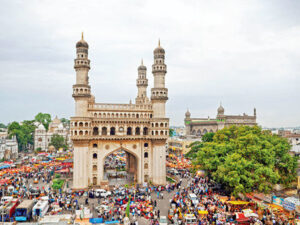Discover Fatehpur Sikri, the UNESCO World Heritage Site, a testament to Indo-Islamic architectural excellence founded by Emperor Akbar in the 16th century.
Served as the Mughal Empire’s capital, it left a significant imprint on Indian town planning with its uniform Mughal architectural style and grand gateways.
Just around 40 km from Agra, a UNESCO World Heritage Site, an exceptional testimony to the Mughal civilization, and the prime destination for the excellence of Indo-Islamic architecture. The typical Mughal walled city of Fatehpur Sikri (the city of victory) was founded by Mughal Emperor Jalal-ud-din Mohammad Akbar in the 16th century.

The walled city of Fatehpur Sikri (the city of victory) is marked by magnificent administrative, residential, and religious buildings comprised of royal palaces, public buildings, Mosques, and living areas for the court, the army, the servants of the king and an entire city. Its form and layout strongly influenced the evolution of Indian town planning and the city was the capital of the Mughal Empire for around 10 years. A unique complex of monuments, all in a uniform architectural style, with well-defined private and public areas and imposing gateways.
It was the first planned city of the Mughals, founded in 1569, a unique example of architectural ensembles of very high quality constructed between 1571 and 1585. Emperor Akbar had planned this city as his capital but the shortage of water compelled him to abandon the city.
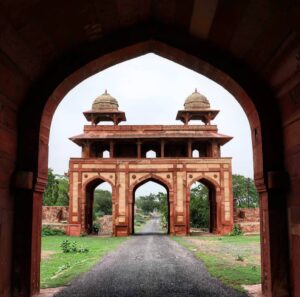
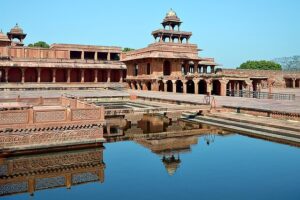
It is believed that Mughal Emperor Akbar visited the village of Sikri to consult the Sufi saint Hazrat Shaikh Salim Chishti, who predicted the birth of an heir to the Mughal throne. When the prophecy came true, Emperor Akbar built his new capital here
Emperor Akbar began the construction of a religious compound in Honour of the Hazrat Sheikh Salim Chishti. A unique white marble encased tomb of the Hazrat Sheikh Salim Chishti, within the Jama Masjid’s courtyard. The single-story structure is built around a central square chamber, within which is the Mazar of the Hazrat Sheikh Salim Chishti, under an ornate wooden canopy encrusted with mother-of-pearl mosaic
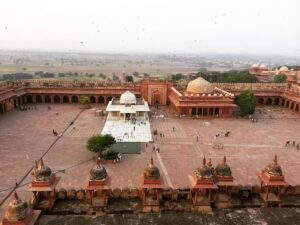
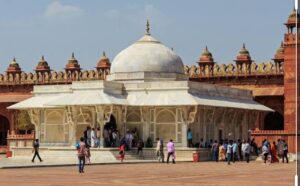
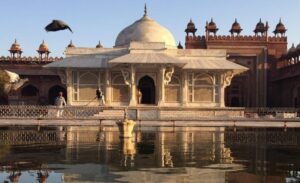

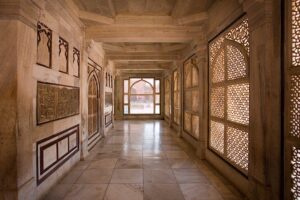
The Jama Masjid, Mosque, in Fatehpur Sikri is the first monument in the complex, an excellent example of Indo-Islamic heritage, completed sometime between 1571 and 1574, remained a “symbol of Mughal heritage and pride”. The Mosque was in honor of Hazrat Shaikh Salim Chishti and was meant to serve as khanqah (monastic school) for the Shaikh’s descendants. In its time, it was extolled by various authors and travelers for its beauty and grandeur
The Jama Mosque of Fatehpur Sikri was highly admired by Emperor Akbar’s son and successor Jahangir, who called it one of his father’s greatest architectural achievements. Mughal Emperor Jahangir discussed the Mosque complex at length with his son Khurram during a stay at Fatehpur Sikri. Khurram went on to become Mughal Emperor Shah Jahan and cited this Mosque as the model for the Jama Masjid at Delhi and the construction of Fatehpur Sikri exercised a definite influence on the evolution of Mughal town planning, at Shahjahanabad (At the present city of Old Delhi)
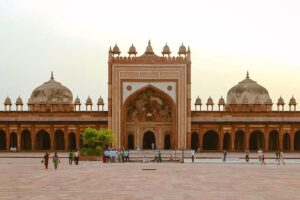
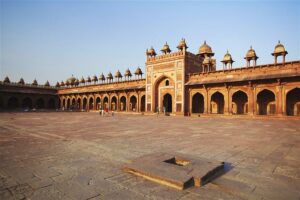
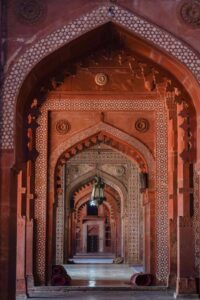
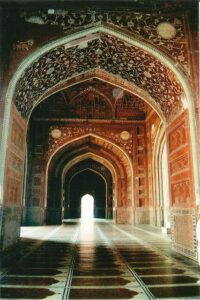
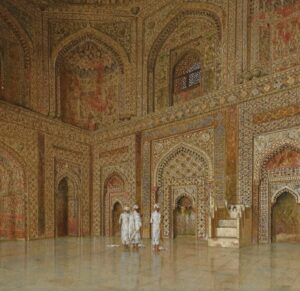
The walled city of Fatehpur Sikri sits on a rocky ridge, predominantly in Red Sandstone, a complex bounded on three sides by a wall 6 km long fortified by towers and pierced by nine gates, includes several impressive edifices of secular and religious nature that exhibit a fusion of prolific and versatile Indo-Islamic styles.
The city was originally rectangular in plan, with a grid pattern of roads and by-lanes which cut at right angles, and featured an efficient drainage and water management system and the buildings are constructed in red sandstone with little use of marble. The city is generally organized around this forty-meter-high ridge and falls roughly into the shape of a rhombus.
The general layout of the ground structures, especially the “continuous and compact pattern of gardens and services and facilities” that characterized the city leads urban archaeologists to conclude that Fatehpur Sikri was built primarily to afford leisure and luxury to its famous royal residents.
The well-defined administrative block, royal palaces, and Jama Masjid are located in the center of the city. The buildings are constructed with the best use of red sandstone with little use of marble.
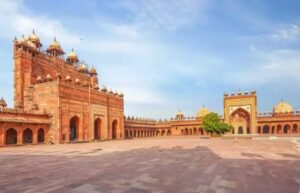
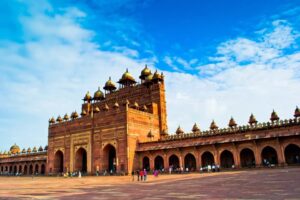
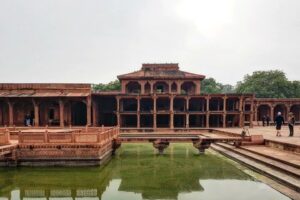
Diwan-i-Am (Hall of Public Audience) is encircled by a series of porticos broken up at one side by the insertion of the emperor’s seat in the form of a small raised chamber separated by perforated stone screens and provided with a pitched stone roof. This chamber communicates directly with the imperial palace complex clustered along a vast court. On the other side of it stands a building popularly known as Diwan-i-Khas (Hall of Private Audience), also known as the ‘Jewel House’
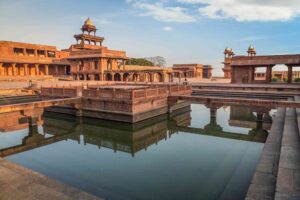
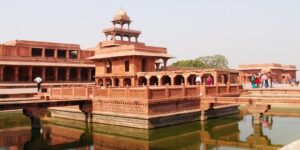
Other monuments of exceptional quality are the Panch Mahal, an extraordinary, entirely columnar five-story structure disposed asymmetrically on the pattern of a Persian badger, or wind-catcher tower; the pavilion of Turkish Sultana and Khwabgah (Sleeping Chamber)


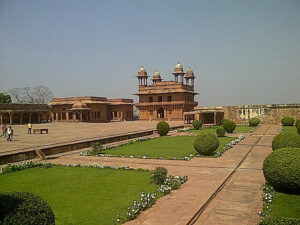
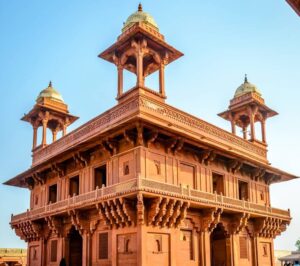
Palace of Jodha Bai, the largest building of the residential complex, has richly carved interior pillars, balconies, perforated stone windows, and an azure-blue ribbed roof on the sides. Birbal’s House and the Caravan Sarai, Haram Sara, baths, waterworks, stables, and Hiran Tower. Architecturally, the buildings are a beautiful amalgamation of indigenous and Persian styles

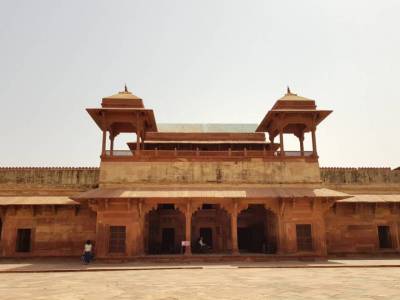

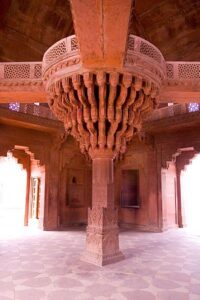
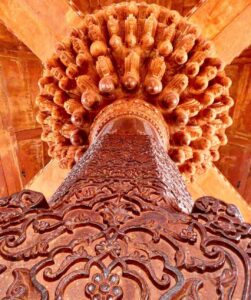
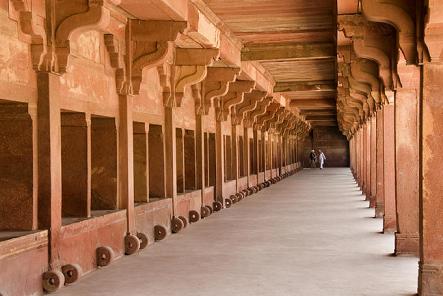
The Hiran Minar, or Elephant Tower, is a circular tower covered with stone projections in the form of elephant tusks. Traditionally it was thought to have been erected as a memorial to Emperor Akbar’s favorite elephant, named Hiram. It also served as a lighthouse for travelers.
It is designed uniquely with its exterior consisting of many tusks-like spikes. This 21.34m high tower got its name after Jehangir converted the polo ground around the tower into a sanctuary for hiran (antelopes). There are 53 steps leading to the top of the tower and one can get a bird’s eye view of Fatehpur Sikri from the top of the tower
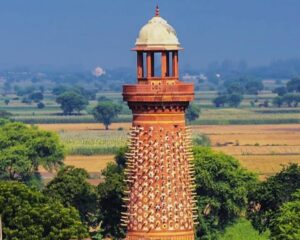

The complex includes a unique Buland Darwaza (High Gate) 180 ft high, one of the highest Gateways in the World, from the ground, gradually making a transition to a human scale on the inside, it carries inscriptions in the archway, which reads “Isa, Son of Mariam said: The world is a bridge, pass over it, but build no houses on it. He who hopes for an hour may hope for eternity. The world endures but an hour. Spend it in prayer, for the rest is unseen” Jesus was advising his followers not to consider the world as a permanent home and hope for worldly things, as human life is of short duration. Verses from the Quran have been carved in the Naskh (script) along the top
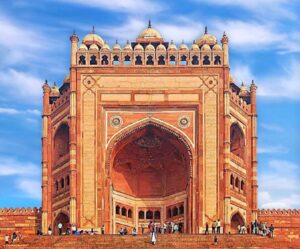
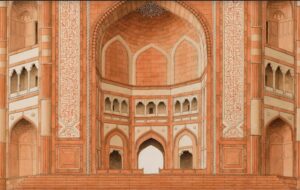
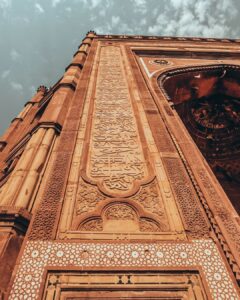

Embark on enchanting Muslim family holidays and group tours in Fatehpur Sikri, immersing yourself in its authentic essence amidst breathtaking landscapes and awe-inspiring Indo-Islamic architectural and cultural heritage.
Explore our well-crafted Muslim-friendly tour itineraries to Fatehpur Sikri and unparalleled Halal tour packages, designed to offer an unforgettable Halal holiday experience and cater to Muslim group travel needs. Immerse yourself in the serene beauty of India’s natural wonders and rich Islamic cultural heritage while enjoying a seamless travel experience throughout your trip.
Discover the captivating allure of India as an enchanting destination tailored for Muslim-friendly tours, highlighted by its array of Halal-friendly travel destinations and amenities, ideal for Muslim group tours and family holiday trips.
Destination India proudly presents a rich tapestry of Islamic heritage tours woven into a great fusion of Indo-Islamic art and culture. Moreover, a multitude of cities and towns across India, imbued with rich Islamic heritage and architectural significance, hold esteemed positions among the globe’s most visited destinations.
With diverse landscapes ranging from serene lakes, vibrant beaches, pristine backwaters, and picturesque valleys to majestic mountains and charming hill resorts with natural wonders that are beyond imagination. India’s wildlife parks and tiger reserves provide exceptional opportunities to observe exotic wildlife in their natural habitats. Many places in India are hailed as some of the world’s most beautiful, ensuring a consistently Halal-friendly environment throughout your travels.
At HalalTrip India, we take immense pride in being the most trusted Halal travel guide for Muslim travelers seeking the best of Halal-friendly tourism in India. We are dedicated to ensuring a seamless and unparalleled Muslim-friendly travel experience throughout India.
Join the countless Halal-friendly travelers who have entrusted us to provide the finest Halal travel experience in India. Allow us to be your reliable travel partner as you unveil the true essence of India and create cherished memories that will last a lifetime.
Write us – travel.HalalTripIndia.com
Follow us – www.facebook.com/IndianHalalTourism

